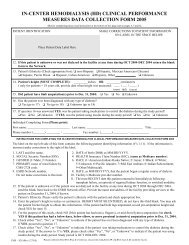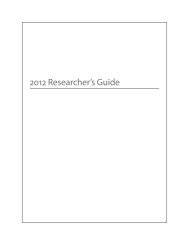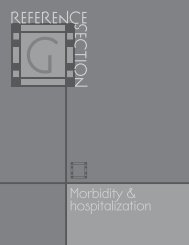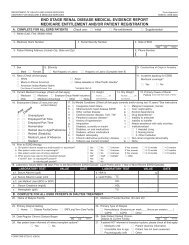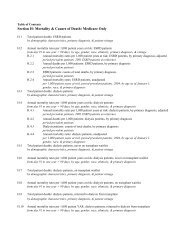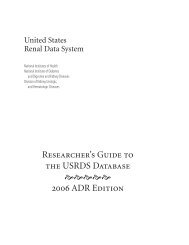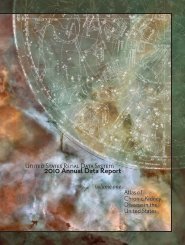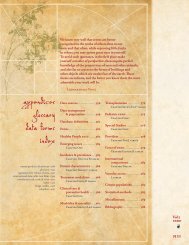4. Patient Characteristics from CMS Medical Evidence Form
4. Patient Characteristics from CMS Medical Evidence Form
4. Patient Characteristics from CMS Medical Evidence Form
Create successful ePaper yourself
Turn your PDF publications into a flip-book with our unique Google optimized e-Paper software.
<strong>Patient</strong> <strong>Characteristics</strong> <strong>from</strong> HCFA <strong>Medical</strong> <strong>Evidence</strong> <strong>Form</strong><br />
USRDS 1999 Annual Data Report<br />
data on comorbidity was collected retrospectively by<br />
medical chart abstraction. CAD was reported among<br />
40.0 percent of patients in the DMMS compared to<br />
21.5 percent reported among patients using HCFA<br />
<strong>Medical</strong> <strong>Evidence</strong> <strong>Form</strong> data. Similarly, CVD was<br />
reported among 12.0 percent compared to 8.2<br />
percent; peripheral vascular disease was reported<br />
among 19.6 percent compared to 13.6 percent, and<br />
congestive heart failure was reported among 36.1<br />
compared to 29.4 percent. Furthermore the level of<br />
agreement between the two data sources is relatively<br />
poor for several comorbid measures, with Kappa<br />
values ranging <strong>from</strong> 0.13 to 0.71. The Kappa values<br />
provide a statistical assessment of agreement between<br />
two data sources, with 1.0 indicating perfect<br />
agreement. Levels below 0.50 indicate poor<br />
agreement. Agreement between the data sources is<br />
also discussed in the section entitled “Reporting of<br />
Comorbid Conditions among New Dialysis <strong>Patient</strong>s”.<br />
Ischemic heart disease or CAD is a common form<br />
of heart disease among ESRD patients. A detailed<br />
description of the prevalence of ischemic heart<br />
disease among new ESRD patients, as reported by the<br />
<strong>Medical</strong> <strong>Evidence</strong> Report <strong>Form</strong>, serves two purposes.<br />
First, it serves to emphasize the great burden of<br />
coronary disease that is present among new patients<br />
starting dialysis, which predicts a shortened life span.<br />
Second, it implies that factors responsible for this<br />
excess burden of disease are present long before the<br />
initiation of dialysis. The reported prevalence of<br />
coronary artery disease among incident dialysis<br />
patients in 1997 was 25.1 percent. Prior documented<br />
myocardial infarction was recorded on this form in<br />
9.4 percent of new patients (Figure IV-6).<br />
The distribution of coronary artery disease among<br />
dialysis patients, both incident and prevalent, has<br />
been addressed using data <strong>from</strong> prior USRDS Special<br />
Studies (Bloembergen; Stack 1998a). These data<br />
suggest that demographic differences exist in the<br />
prevalence of coronary disease. National data<br />
collected on incident dialysis patients as reported on<br />
the <strong>Medical</strong> <strong>Evidence</strong> Report <strong>Form</strong> also emphasize<br />
that similar differences exist. Males were reported to<br />
have a greater prevalence of ischemic heart disease<br />
and myocardial infarction than females (27.0 percent<br />
vs 22.9 percent and 10.6 percent vs. 8.1 percent)<br />
(Figure IV-7). Similarly, diabetics were reported to<br />
have a greater burden of clinical coronary disease<br />
than nondiabetics. The prevalence of ischemic heart<br />
disease and acute coronary events was observed to<br />
increase with age as it does in the general population<br />
as show in Figure IV-8. The distribution of coronary<br />
artery disease by race and ethnicity is shown in<br />
Figure IV-9. These data confirm observations of<br />
other USRDS Special Studies (Stack 1998a; Stack<br />
1998b). White, Native American, and “Other” race<br />
had the highest prevalence of ischemic heart disease<br />
(CAD) (30.6 percent, 22.0 percent and 19.5 percent<br />
Ischemic Heart Disease (CAD) and Myocardial<br />
Infarction (MI) by Race and Hispanic Ethnicity in New<br />
Dialysis <strong>Patient</strong>s, 1997*<br />
35<br />
30<br />
25<br />
20<br />
15<br />
10<br />
5<br />
0<br />
New <strong>Patient</strong>s (%)<br />
30.6<br />
11.8<br />
1<strong>4.</strong>8<br />
5.1<br />
17.6<br />
5.6<br />
22.0<br />
CAD<br />
9.3<br />
19.5<br />
White Black Asian Native Other Hispanic Non-<br />
American<br />
Hispanic<br />
*Reported on HCFA <strong>Medical</strong> <strong>Evidence</strong> <strong>Form</strong><br />
5.9<br />
Figure IV-9<br />
MI<br />
20.2<br />
6.0<br />
25.7<br />
9.8<br />
IV -9<br />
USRDS 1999<br />
Ischemic heart disease (CAD) and Myocardial Infarction (MI) by race and Hispanic ethnicity for new dialysis<br />
patients, 1997. Source: Reference Table L.18.<br />
64




